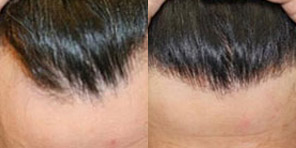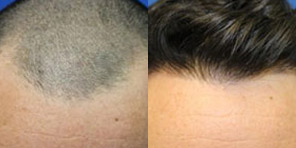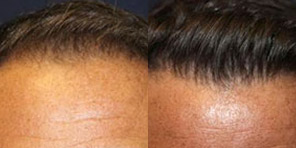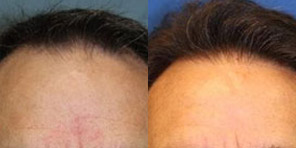Robotic Hair Transplant
Consultations offered at our four convenient locations in La Jolla, San Diego, Newport Beach and Beverly Hills
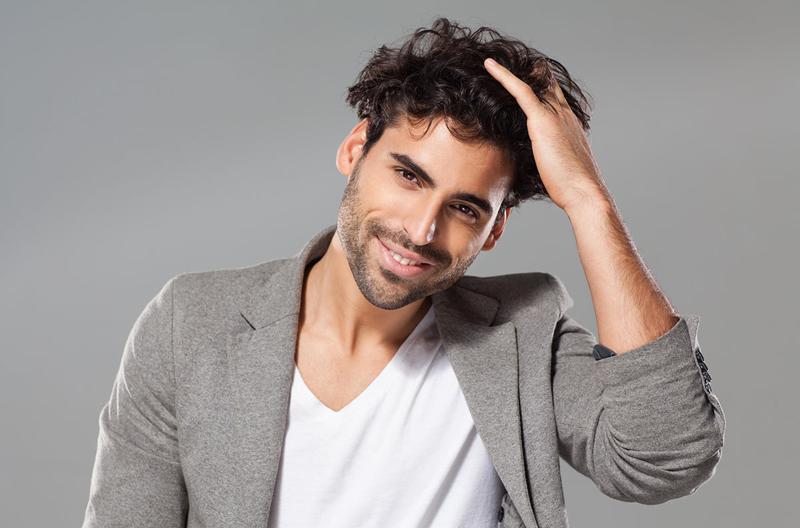
A robotic hair transplant, also known as follicular unit extraction (FUE) with robotic assistance, is a state-of-the-art procedure that combines advanced robotic technology with the precision of artificial intelligence (AI) in hair transplant surgery. If you are struggling with hair loss, the good news is that it does not need to be permanent. With a robotic hair transplant, we can restore hair growth in areas where you are experiencing bald patches or extreme thinning. Restoring your hair will help you feel better about your appearance.
Dr. Robert Chaffoo is a triple board-certified plastic surgeon with decades of experience treating patients with hair loss. The team of specialists at California Hair MD uses the ARTAS system for hair restoration, and our hair loss solutions have helped thousands of patients achieve life-changing results.
You do not need to live with hair loss. Contact our office or call (800) 373-4773 to get started at one of our locations:
Contents
- 1 About Hair Loss
- 2 Robotic Hair Transplants Benefits
- 3 Candidates
- 4 Consultation
- 5 How to Prepare for a Robotic Hair Transplant
- 6 ARTAS Robotic Hair Restoration Procedure
- 7 Hair Transplant Recovery
- 8 Robotic Hair Transplant Results
- 9 Corresponding Hair Transplant Procedures
- 10 Cost of a Robotic Hair Transplant in Newport Beach
- 11 FAQ
- 11.1 How long will it take to see results from a robotic hair transplant?
- 11.2 How long does FUE hair restoration take?
- 11.3 Does a robotic hair restoration treatment involve scarring?
- 11.4 Is robotic hair restoration a painful procedure?
- 11.5 What happens to the existing hair in the recipient area after robotic hair restoration?
- 12 References
About Hair Loss
Hair loss can affect your entire appearance and well-being. Thinning hair at the crown and the hairline can affect the way you feel about yourself and your quality of life.
Genetic Hair Loss
Androgenetic alopecia, genetic hair loss, or pattern hair loss, is a condition caused by genetics that can become progressively worse as you age. By age 30, approximately 30% of men will experience genetic hair loss. (1)Approximately 67% of men and 24% of women worldwide struggle with the condition. (2) The good news is California Hair MD has helped thousands of patients achieve results and reverse the effects of hair loss.
Hair Growth Cycles
Shedding is a natural part of the hair growth process. The issue occurs when you experience excess shedding that happens faster than your hair can regenerate. At California Hair MD, we will analyze your scalp with the Hair Metrix System to determine which phase your hair is in before we start treatment for the best results with the Hair Metrix System. There are three main phases in hair growth: telogen, catagen, and anagen. During the telogen phase, your hair stops growing and rests. During the catagen phase, the hair falls out. When the anagen phase begins, your scalp produces new hair from the same follicle that previously shed hair. To maximize the results of your robotic hair transplant, we will extract healthy follicles and place them strategically around the scalp for even hair growth.
ARTAS i-X-i
ARTAS i-X-i Robotic Hair Restoration restores your hair at the follicular level by discreetly extracting hair follicles from a predetermined donor area and placing them in locations where you are experiencing hair loss for a more even appearance. Using advanced AI, the device is programmed to examine your scalp and determine the best location to harvest follicles from as well as place them for ideal growth.
Robotic Hair Transplants Benefits
A Robotic Hair Transplant is one of the most effective ways to restore your hair and recover your appearance. The benefits of a robotic hair transplant include the following:
- Precise hair placement for even growth
- Eliminates risk of human error
- Minimally-invasive procedure
- Minimal scarring
- Quick recovery
- Even hair growth
- Preserves healthy follicles
- Long-lasting results
Candidates
Ideal candidates for robotic hair transplantation are individuals experiencing hair loss or thinning hair, whether due to genetic factors, hormonal changes, trauma, or other conditions. They must have enough hair present in a prospective donor site to be considered for treatment. Candidates typically have good overall health and realistic expectations for the outcome of the procedure. Age is not a limiting factor, as long as the patient is healthy enough to undergo surgery.
Consultation
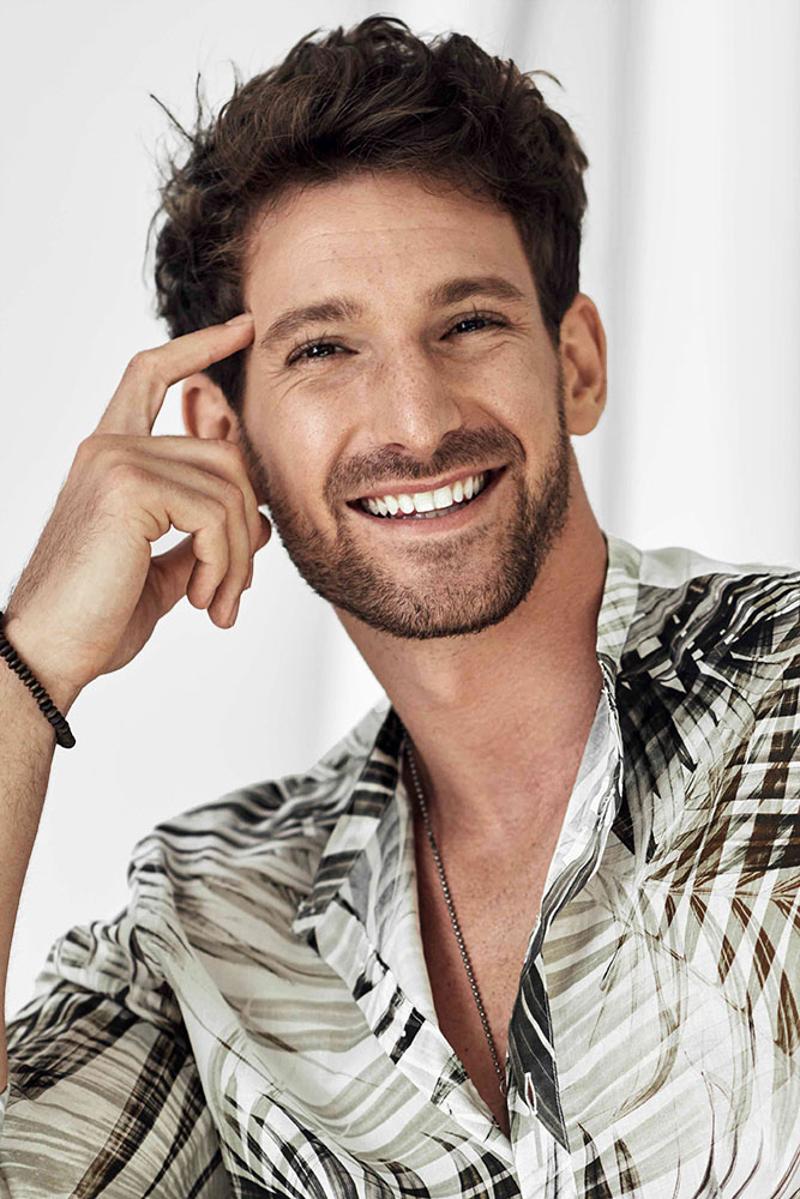
During your personal consultation, Dr. Chaffoo will ask about your medical history and lifestyle and will assess the current health of your scalp with a physical examination. He will also discuss any medications you are currently taking and factors that could be contributing to your hair loss such as stress, diet, aging, and lifestyle factors. He will take all factors into consideration to help determine the best methods for restoring your hair.
How to Prepare for a Robotic Hair Transplant
To prepare for robotic hair restoration you will need to stop smoking 1-2 weeks before your procedure for the best results. You will also need someone to drive you home after the procedure. If you take blood thinners, our team may recommend stopping them before your procedure as well. Please arrive at the office in comfortable clothes.
ARTAS Robotic Hair Restoration Procedure
During robotic hair restoration, we will extract hair follicles from your scalp and place them in areas where your hair is no longer growing. The procedure is physician-assisted, so the whole process will be monitored by Dr. Chaffoo. During the procedure, Artas i-X-i will scan the scalp with stereoscopic imaging to look for areas to harvest hair follicles. The device is efficient at harvesting hair and determining the best location to place it for a natural look. It has been programmed with AI technology for the most effective hair placement methods. During the transplantation process, the AI technology helps place follicles correctly to minimize damage to existing healthy hair follicles. The result is a smooth, even look that appears natural.
Hair Transplant Recovery
After your procedure, you will need to avoid washing your hair for two days. You will also need to avoid intense physical activity for approximately three weeks for the best results because exercise can increase blood flow to the scalp. Over the next few months, your body will begin to produce new hair where the follicles were placed. Hair growth can take time, and your body will need to adjust to the placement of new hair follicles. After one year, you will see the full effects of the treatment and a more even scalp.
Robotic Hair Transplant Results
After a robotic hair transplant procedure, you can enjoy thick, even hair growth. You will also notice a more youthful, natural appearance and long-term results. To learn more about how we can help you restore your hair, see our blog.
Corresponding Hair Transplant Procedures
Hybrid Hair Restoration
During a hybrid hair restoration treatment, we can use follicular unit extraction (FUE) in combination with topical and oral treatments to restore your hair. With the SmartGraft method, we can manually remove follicles and reposition them for even hair growth. We can also use the semi-automated NeoGraft method to stimulate hair growth by extracting hair follicles with reverse pneumatic pressure at a depth that will help you achieve a natural result. The method you need will depend on your treatment plan. To learn more about hybrid hair restoration methods, schedule a consultation.
Cost of a Robotic Hair Transplant in Newport Beach
The cost of your ARTAS treatment will depend on the amount of hair loss that you need to address and the amount of hair that is harvested. After your consultation and exam, we will provide an all-inclusive quote for your treatment plan. To learn more about how our team of hair restoration specialists can restore your long, beautiful hair, contact our office to schedule an appointment:
FAQ
How long will it take to see results from a robotic hair transplant?
Hair takes time to grow. You can enjoy the full benefits of your treatment around one year after your procedure for the best results.
How long does FUE hair restoration take?
The duration of the procedure depends on factors such as the number of grafts required and the extent of the hair loss being addressed. On average, FUE hair restoration can take several hours to complete. Shorter sessions could take 4-5 hours, while longer sessions can be 6 or more.
Does a robotic hair restoration treatment involve scarring?
The scarring associated with ARTAS robotic hair restoration is minimal and virtually undetectable. The procedure utilizes small, dot-like incisions for donor hair extraction, which typically heal and blend seamlessly with the surrounding scalp.
Is robotic hair restoration a painful procedure?
Local anesthesia is used during ARTAS robotic hair restoration, ensuring that the procedure is generally well-tolerated by most patients.
What happens to the existing hair in the recipient area after robotic hair restoration?
The existing hair in the recipient area is not affected by the transplant procedure and continues to grow normally. The transplanted hair merges seamlessly with the surrounding existing hair, providing a natural-looking result.
References
- Salman, Kubra Esen, et al. “Frequency, Severity and Related Factors of Androgenetic Alopecia in Dermatology Outpatient Clinic: Hospital-Based Cross-Sectional Study in Turkey.” Anais Brasileiros de Dermatologia, vol. 92, no. 1, 2017, pp. 35–40, www.ncbi.nlm.nih.gov/pmc/articles/PMC5312176/, https://doi.org/10.1590/abd1806-4841.20175241.
- Kische, Hanna, et al. “Sex Hormones and Hair Loss in Men from the General Population of Northeastern Germany.” JAMA Dermatology, vol. 153, no. 9, 1 Sept. 2017, p. 935, https://doi.org/10.1001/jamadermatol.2017.0297. Accessed 29 Mar. 2020.

